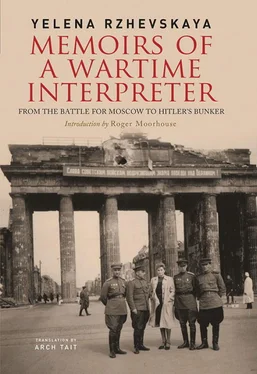Be that as it may, people decided that Hitler shot himself. Thus, Hitler’s orderly, Bauer, who shortly after met the SS guard Mengershausen, told him that. Other close associates of the Führer said the same.
Was there really a shot in Hitler’s room, or did those awaiting the end outside the doors imagine it? And if there was, who fired it? The testimony of the head of Hitler’s bodyguard, Hans Rattenhuber, sheds light on this. He writes,
At about three or four in the afternoon, when I went into the anteroom I noticed a strong smell of bitter almonds. Högl, my deputy, told me with distress that the Führer had just committed suicide.
At that moment Linge came to me. He confirmed the news of Hitler’s death, adding that he had just had to carry out the most difficult order the Führer had given him in his life.
I looked at Linge in surprise. He explained to me that just before he died, Hitler ordered him to leave the room for ten minutes, then re-enter, wait another ten minutes, and carry out the order. At this, Linge quickly went into Hitler’s room and returned with a Walther pistol which he put on my desk in front of me. From its special exterior finish I recognized it as the Führer’s personal pistol. It was now clear to me what Hitler’s order had been.
Hitler, evidently uncertain that the poison would prove effective because of the many injections he had been having every day for a long time, ordered Linge to shoot him after he took it. Reichsjugendführer Axmann, who was present during this conversation, took Hitler’s pistol and said he would hide it until better times.
Rattenhuber evidently did not know another circumstance that prompted Hitler to give that order to Linge. The problem was that, when the poison was tested on a second dog, the poisoned puppy struggled against dying for a long time and was then shot. This was established at the autopsy of the dead dogs found in the crater, although at first it was overlooked and is not mentioned in the report detailing how they were found.
The conclusion reached by the doctors was,
The manner in which the dog was killed appears to have been as follows: it was first poisoned, possibly using a small dose of cyanide compounds and then, when it had been poisoned and was in its agony, it was shot.
This may have heightened Hitler’s fear, as he watched the poisoned dogs, that the poison might not work.
‘Linge shot Hitler,’ Rattenhuber wrote in his testimony.
I imagined that Linge’s hand might have been shaking when he shot at the dead Führer and the bullet missed him. So if a shot really did ring out in Hitler’s room, was it Linge who pulled the trigger? But there was no sign of a shot.
The autopsy report on Eva Braun notes a chest wound. In the first edition of my book I suggested that the bullet might have hit the dead Eva, but after the book was published I received a letter from Faust Shkaravsky drawing my attention to the fact that this was not a bullet wound. The report says, ‘Evidence of a shrapnel wound to the thorax with haemothorax, damage to the lung and pericardium, six small metal fragments.’
‘When and how this wound occurred I cannot say with confidence,’ Shkaravsky wrote, ‘but it is entirely possible that while the body was being taken out of the Führerbunker it was damaged by shrapnel from a mine or artillery shell.’
A long time later, when the State Archive of the Russian Federation declassified a large number of documents, the following evidence came to light: a year after the events I am describing, in May 1946, the Ministry of Internal Affairs organized a special expedition (code-named ‘Myth’!) to the bunker in Berlin in order to collect data to support the claim about Hitler’s ‘disappearance’. This initiative came not from Stalin, but was born of the rivalry between two government departments: the Ministry of Internal Affairs and the Smersh Counter-intelligence Department. Witnesses were also brought to Berlin: Hitler’s adjutant (Günsche), his valet (Linge), and other staff who served him who were in Russian captivity. However, no matter how much duress was applied to get them to admit that Hitler was alive, they answered as one: ‘He is dead and we cannot make him alive.’
Contrary to its own mission, the expedition discovered yet another piece of evidence that Hitler had committed suicide. From the bomb crater where the burnt remains were found in May 1945, after further excavation, two detached fragments of skull bone were discovered, one of which showed signs of a bullet exit wound (the absence of part of the skull is noted in the autopsy report of 8 May 1945). This, of course, suggested Hitler had shot himself, but since it was impossible to dismiss the data from the first examination, which had established that Hitler was poisoned, an assertion appeared in print that he had simultaneously taken poison and shot himself. Many experts doubt the feasibility of performing these two actions simultaneously. The account given in the testimony of the head of Hitler’s bodyguard, Rattenhuber, seemed convincing to me: Hitler, fearing the poison would be insufficiently effective, ordered his valet to shoot him after he had been poisoned, and the order had been carried out. And perhaps the ‘bullet exit wound’ is the missing evidence of Linge’s shot. But I am not going to join this polemic. Just as then, when Hitler’s remains were found, so now, in May 2007, I find the whole controversy profoundly uninteresting. What really mattered was that Hitler was dead.
Subsequently, Faust Shkaravsky confided in a letter to me that he still had a feeling of ongoing unfairness: the Commission was strictly forbidden to photograph Hitler’s body, whereas the Commission was photographed in full force next to Goebbels’ body strapped to the dissection table. There are also plenty of photographs taken during the investigation. But with Hitler, oh, no! Shkaravsky was not privy to the circumstances that required that prohibition.
Here again, chance played an important part. During the autopsy it was found that Hitler’s dentures and teeth had come through surprisingly intact. The autopsy report includes two large non-standard sheets of paper documenting Hitler’s teeth in meticulous detail. The experts removed the dentures (and lower jaw). Now the crucial task was, at all costs, to find Hitler’s dentists.
The Burgundy Coloured Box
In Berlin-Buch on 8 May, the very day when the document of surrender of Germany was ratified in Karlshorst, although I did not yet know that, Colonel Gorbushin called me in and handed me a box, saying it contained Hitler’s teeth and that I was answerable with my head for its safe-keeping.
It was a second-hand, burgundy red box with a soft lining and covered with satin, the kind of thing made to hold a bottle of perfume or cheap jewellery.
Now, however, what it held was the irrefutable proof that Hitler was dead, because in all the world there are no two people whose teeth are exactly alike. In forensic medicine this is held to be the fundamental anatomical item that clinches any argument about a person’s identity. Moreover, this evidence could be preserved for many years to come.
The box was entrusted to me because the safe was still back with the second echelon and there was nowhere secure to put it. Why me? For the simple reason that everything connected with Hitler was being kept top secret and must not be allowed to leak out from Gorbushin’s group which, as already mentioned, had dwindled by now down to just three people.
All that day, so pregnant with the sense of imminent victory, it was decidedly tiresome to be carrying a box about, and to turn cold whenever I thought of the possibility of accidentally leaving it somewhere. It burdened and oppressed me.
Читать дальше











